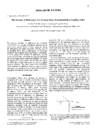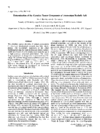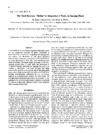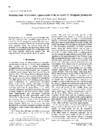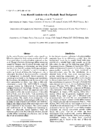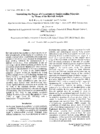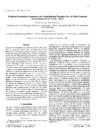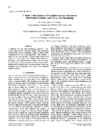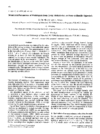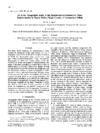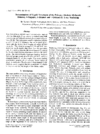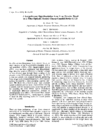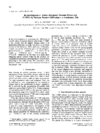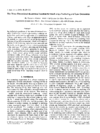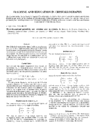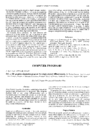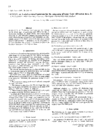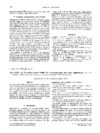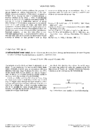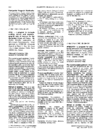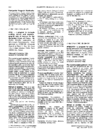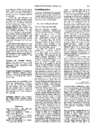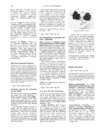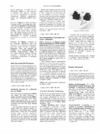issue contents
April 1995 issue

Cover illustration: The observed X-ray diffuse scattering in the (h0l) section of 1,3-dibromo-2,5-diethyl-4,6-dimethylbenzene. Courtesy of T. R. Welberry and B. D. Butler.
research papers
An approximation is found for the number of reflections for trajectories that are transmitted by a cylindrical channel illuminated by a beam with a square angular divergence from a rectangular neutron guide. The results are compared with those for a numerical simulation.
The gyration components of ammonium Rochelle salt are measured using a universal polarimeter. The dispersion of the gyration is given over the wavelength range 350-650 nm.
A new procedure is described for the integration of diffraction peaks on imaging plates. The new `seed-skewness' method is shown to lead to more reliable intensities, especially for the weaker reflections.
The crystal structure of an approximant quasicrystal with a giant unit cell is refined.
Numerical and analytical methods are used for determining the resolution function for small-angle neutron scattering. Effects of beam-stop shadowing are also considered.
A Rietveld X-ray analysis is developed where the background scattering is described with equations based on physical principles.
The degree of crystallinity in semicrystalline materials has been determined with a Rietveld analysis with an internal approach based on Rietveld's method.
A preferred-orientation analysis for powder diffraction data is proposed based on an extension of the Wilson-plot intensity analysis in order to correct integrated intensities for structure determination.
The structure refinement and estimation of various models of vacancy ordering in γ-Fe2O3 were performed. Attention is paid to the superstructure orientation with respect to well developed planes of microcrystals that depend on the precursor.
The method described, based on the `column-like' crystal model, can be applied to both single-and multiple-order reflections. The experimental diffraction peak is fitted by a sum of elementary components represented by interference functions.
An analytical approximation is derived for easy calculation of the X-ray reflectivity pattern in low-reflectance multilayers. It allows the identification of pattern features most sensitive to certain structural parameters (average layer thicknesses and external and internal roughness).
X-ray topographic methods are used to examine the influence of the paraelectric-to-ferroelectric phase transformation on the crystal perfection of single crystals of ammonium sulfate.
X-ray scattering intensities of the primary alcohols were measured with transmission and reflection methods. The radial distribution functions were calculated and a fitting procedure was used to obtain individual atomic distances and coordination numbers.
An efficient two-dimensional X-ray detector based on direct imaging of an X-ray-sensitive phosphor with a high-resolution (1024 × 1024) charge-coupled device (CCD) array has been constructed and characterized. High detective quantum efficiency is obtained without an intensification stage.
Yttria-tetragonal zirconia polycrystal (Y-TZP), which has sometimes been assumed to be single-phase tetragonal, is shown to contain substantial (10-20%) quantities of cubic zirconia as the phase diagram predicts. The conclusions from previous studies have been examined in the light of this result.
An analytical calculation of the three-dimensional resolution function for a small-angle neutron scattering set-up has been performed by application of phase-space analysis and Gaussian approximations.
teaching and education
Free 

A rigorous proof of restrictions on rotation, inversion and roto-reflection axes in crystals in three dimensions is presented using transformation matrices, also that the traces of similar matrices are identical.
short communications
A device is described that is useful for the recovery and re-exposure of frozen crystals and for data collection from frozen crystals at different orientations.
computer programs
A brief description of a 3D graphics simulation program for single-crystal diffractometry is presented. The program displays both χ- and κ-type diffractometers with a zero-dimensional (conventional) counter or a two-dimensional area detector and simulates the process of data collection.
LAUEGEN is an X-windows-based program for carrying out the initial data-processing stages for Laue X-ray diffraction data. It has facilities for Laue simulations, image display and crystal orientation determination and refinement.
XDL_VIEW is an easy-to-use X-windows-based toolkit for crystallographic and more general applications. It has interfaces for both Fortran and C.
laboratory notes
A simple innovation that allows convenient parallel crystallization trials of multiple samples using hanging drops is described.
A modification to a standard X-ray beam tunnel that eliminates absorption of X-rays by air is described.
computer program abstracts
FHKL is a menu-driven X-windows program to compute structure factors, dielectric susceptibilities, absorption coefficients and crystal rocking curves, taking into account dispersion corrections, thermal agitation and polarization.
The program BREADTH calculates coherent domain sizes and lattice strains according to the `simplified' and `double-Voigt' integral-breadth methods.
crystallographers
Free 

new commercial products
Free 

books received
Free 

Free 



 journal menu
journal menu









